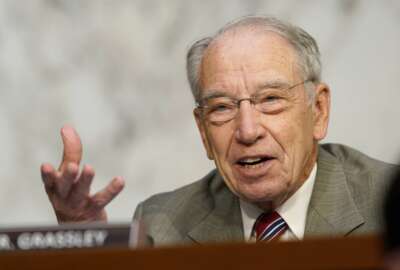Hubbard Radio Washington DC, LLC. All rights reserved. This website is not intended for users located within the European Economic Area.
On Air: Federal News Network
Trending:
10 questions on GSA’s hallways initiative
Mike Sade, a former federal acquisition executive, said the consolidation of schedule contracts makes sense, but there are several unanswered questions GSA need...
Commentary by Mike Sade

What is now being called hallways has been discussed for many years and has been pushed by contractors that have schedule contracts across the multiple categories. A hallway has the potential to decrease the cost to customers, GSA and schedule contractors who will be managing fewer schedule contracts. In addition, it can provide greater opportunities for contractors that hold only one of the MAS contracts that will be moved into the hallway. This is particularly true for companies that are small and in other socio-economical categories.
A hallway is great in concept, but there are some important contractual questions that must be addressed:
- How will this affect contractors that may not be on all of the schedules that will be folded into a hallway?
I believe it must be clear to contractors that may not be on all the contracts that will move to the hallway that they are eligible to propose on specific Special Item Numbers (SINs) and not required to propose on all of the SINs that will be listed on the new schedule contract. GSA must allow existing contractors to propose on new SINs they may not currently have under an existing contract.
- What happens to the existing Special Item Numbers under existing MAS contracts?
Thought must be given to how the new hallway SINs will be structured. I don’t believe they can just move existing SINs to a new contract. There must be an analysis of existing SINs, how they have been used and look at the future buying needs of customers and how contractors offer their services.
- Will contractors need to submit new proposals for the newly created “hallway”?
It would be easy to take the existing MAS contracts and merge them. However, I believe this is an opportunity for GSA and contractors to rethink current SIN structure and provide opportunities for existing and potentially new contractors to submit new proposals.
- How will the existing line item rates be determined?
I can see a single SIN having multiple labor rates based on geographic locations and not just “onsite” or “remote” locations. A contractor, particularly a small business, should not be bound to bid a national rate when it will only be proposing on delivery orders based on its location.
- How will the savings be realized by the taxpayer? Will GSA reduce their Industry Funding Fee (IFF) on orders? Will industry reduce their rates due to reduced administrative cost?
I want to stress I am for this change and advocated this type of change during my time at GSA. It needs to be well managed and consider the ecosystem (as Kymm McCabe, CEO at ASI Government, pointed out in a LinkedIn comment).
What will be the impact on the government customer (federal, state and local), GSA and industry and how they operate?
Although my questions above focus more on the contractual issues, there are other concerns that will be affected by political, economic and information technology factors. What are those considerations?
- What will be the effect on the workforce — both government and industry and the employees union?
Creating the hallway certainly should reduce the cost by reducing the number of contracts that must be maintained and therefore the number of employees required to administer them. If this leads to a reduction in the required workforce for both government and industry, those reductions must be managed in a way that complies with existing collective bargaining agreements
- What will be the revenue impact on GSA and industry and the system changes required to implement these hallways?
I believe the revenue impact will be an increase in use of the schedules, which means higher revenue for GSA and potentially the contractors. For GSA, the increase will come from greater use of the hallway. Today, many agencies will use schedules under the hallway where in the past if they could not get the “solution” from any one specific schedule contract. For industry, I don’t believe there will be a significant change in revenue. However, due to lower administrative costs, they may achieve higher margins.
- What will be the impact of the change on contractors in the socioeconomic categories such as women-owned or service disabled veteran-owned small businesses?
GSA must do a thorough analysis of how this will impact small business. As noted above, I believe by creating the hallway GSA has an opportunity to provide greater opportunity for small businesses to participate more and win more business by rethinking how SINs are structured. I think there is an opportunity to structure SINs based on geographic considerations that can create an economic advantage for small business.
- What will be the cost and extent of the changes required to IT systems by GSA and industry to accommodate this change?
There will be changes required to the financial, process and oversight systems that must be understood, mapped and planned. As a result, any savings will not be realized immediately and costs to make these changes may increase the cost initially.
- How will GSA and industry measure the success of this change? So, how will GSA manage the change and answer these questions? What is the path forward? How can GSA use new technology to implement this concept?
It is time for transparency. It is easy to declare change. It is another thing to justify it and implement it. I have attempted to propose some solutions to some of the questions. Answering all of these questions requires deeper and open discussion. I believe this significant change should be treated as a major program. There should be a clear business case developed to justify the change and to articulate clearly the benefits and the return on investment.
This discussion should start with GSA sharing its “draft” business case that addresses the questions I raised so government customers and industry can respond, discuss and debate the change. All we have seen or heard is GSA telling us “this is what we heard from our customers and industry”.
There are plenty of government and industry forums, including publications such as this one, for GSA to share information that will support a business case for this change. The new Interact.gsa.gov site is a great start, but more information must be shared and not just respond to questions. I offer this not as a criticism but an observation of how GSA can enroll the community in what I believe is a positive change to how the government buys.
Mike Sade is a former senior procurement executive at the Commerce Department, assistant commissioner in GSA’s Federal Acquisition Service and a director of acquisition support at the Homeland Security Department’s Customs and Border Protection directorate. He is now president of Sade Associates.
RELATED STORIES:
GSA predicts new initiatives will light the path toward better governmentwide acquisition
Copyright © 2024 Federal News Network. All rights reserved. This website is not intended for users located within the European Economic Area.




